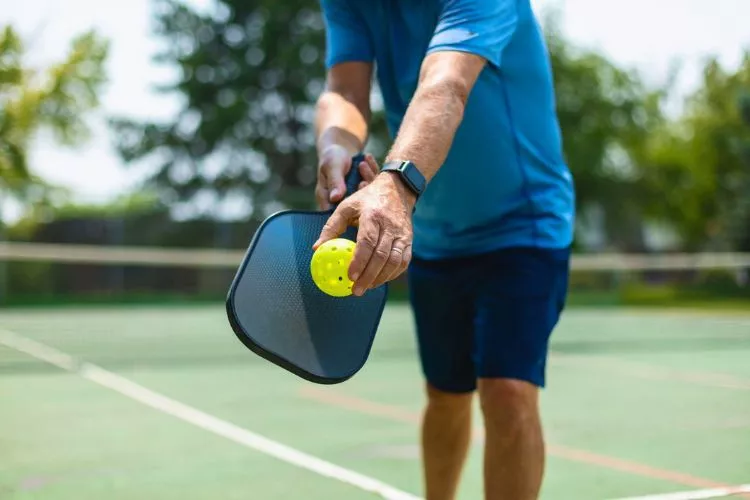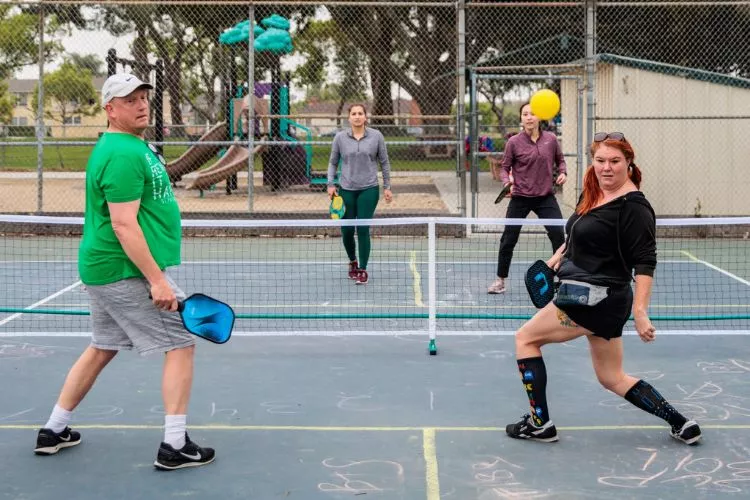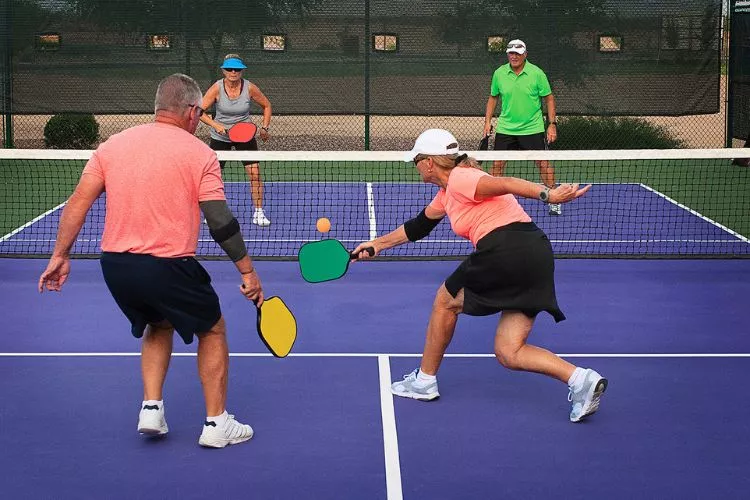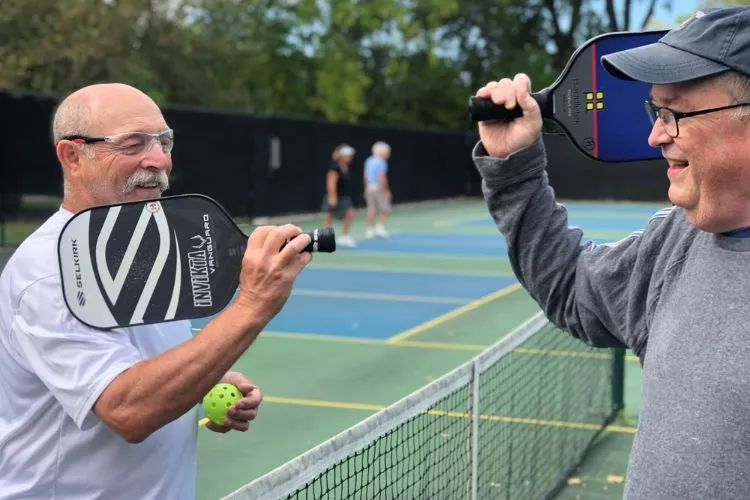Pickleball, a fast-growing sport combining elements of tennis, badminton, and table tennis, is enjoyed by players of all ages and skill levels. A key aspect that sets pickleball apart from other racquet sports is its unique scoring system, which can be initially puzzling for newcomers.
A clear understanding of pickleball scoring system is crucial to fully enjoy and unlock the game’s strategic potential. Here I will provide a comprehensive and informative overview of the pickleball scoring, breaking down the various rules and regulations clearly and concisely.

Whether you’re a beginner looking to familiarize yourself with the game or an experienced player seeking to sharpen your strategy, this introduction to pickleball scoring will equip you with the knowledge to confidently embrace this engaging and dynamic sport.
Pickleball Scoring System: Detailed Guide
Understanding the scoring system of pickleball helps both beginners and expert players become better at the game. Here’s a detailed look at how scoring in pickleball works:

1. The Score
Serving & Scoring
- Only the serving team has a chance to score points.
- Points are scored when the opposite team either fails to return the ball legally or steps on one of the many lines marked on the court during a volley.
- There are many ways that a serve can be faulted, meaning the server won’t have a chance to score that round. For instance, a served ball must land in the opposite diagonal court; if it doesn’t, it’s considered a fault.
Point Limits
- A pickleball game is typically played to 11 points. However, tournament games may be played to 15 or 21 points.
- A team needs to win by a margin of at least 2 points.
2. Serving
Single Server
Pickleball can be played in singles or doubles. In singles, each player serves from the right-hand side when their score is an even number and from the left side when it’s an odd number.
Double Server
In doubles, only one partner is allowed to serve at the start of the game and then the service alternates between the two team members until they lose their serve by losing a point.
Server Switch
When serving changes to the opposing team, the first serve is always made from the right-hand side of the court.
3. Sequence
- The first team to serve in a game scores three numerical values during each service: the first number for serving team’s score, the second for receiving team’s score, and the server number (1 or 2).
- The sequence remains the same throughout the game. E.g. if the serving team’s score is 4, opposing team’s score 6, and it’s the first server, the score would be announced as 4-6-1.
What do the 3 numbers mean in pickleball?
In pickleball, the three numbers announced during scoring represent crucial pieces of information that help players keep track of the game’s progress. Here’s an explanation for each number:

- Serving team’s score: The first number announced indicates the current score for the serving team. Points are only awarded to the serving team, so this number changes when the serving team successfully wins a rally.
- Receiving team’s score: The second number represents the current score for the team receiving the ball. This number stays the same until the receiving team gets the serve and subsequently scores points.
- Server number (1 or 2): The third number denotes which server is up in doubles play. The number is either ‘1’ or ‘2’ to distinguish between the first or second server on the serving team. A serving sequence comprises both partners having a turn to serve, and this number helps keep track of that sequence.
Why does pickleball start with 0 0 2?
When a game of pickleball starts, the score begins at “0-0-2”. Here’s why:
- The first “0” represents the score of the serving team.
- The second “0” denotes the score of the receiving team.
- The “2” indicates the second server’s turn to serve in doubles play. However, it seems counterintuitive as there is only one server at the beginning of the game.
This unique rule arises because when a game begins, only one starting team member gets to serve before service passes to the other team. To keep the flow of the game, stating “0-0-2” implies this server is the ‘second’ server, indicating that once this server loses a point, service will pass to the opposing team. This rule maintains pickleball’s alternative serving between each team and every player after that follows the typical “first server”, “second server” pattern.
What are the 3 ways to score in pickleball?
Scoring in pickleball is unique and regulated through the following three scenarios:

- Scoring on Serve: Only the serving team can score points in pickleball. Scores are made when the opposing side commits errors or faults, for example, when their return is out of bounds, doesn’t clear the net, lands in the non-volley zone (kitchen), or volley from the non-volley zone.
- Scoring through Double-Bounce Rule: The double-bounce rule (two-bounce rule) is a fundamental pickleball rule contributing to points. Both the service and service return should bounce once before they are volleyed. A fault occurs if the rule isn’t followed, and the serving team scores a point.
- Scoring through Violations: Fouls like touching the net, hitting the ball twice, or violating kitchen rules can lead to the opposing team scoring points. Strategy, thus, becomes important to avoid unnecessary violations.
Remember: a game ends at 11, 15, or 21 points, but the team must win by at least two points.
How to keep score in pickleball singles?
Scoring in singles pickleball is simpler than doubles. The main principle remains that only the serving player can add points to their score. Here’s a step-by-step guide:

- Start of the Game: The game begins with the right side serving. The score is announced as 0-0.
- Scoring on Serve: If the server wins the rally, they get a point. The score becomes 1-0 and they switch sides to serve from the left. This move helps keep track of even and odd scores.
- Serve Loss: If the server doesn’t win a rally, the serve switches to the other player. For example, if the scorer initially was serving and lost a rally, the score is announced as 0-1, indicating the non-champion server is now the server.
- Continue the Pattern: As the game progresses, the server continues to alternate between right and left sides depending on whether their score is even or odd.
- Game End: The game ends when a player reaches 11, 15, or 21 points (depending upon agreed rules) and is two points ahead of the opponent.
You May Also Find Useful: What is a key strategy in pickleball? | Pickleball Beginner’s Mistakes
Common Scoring Mistakes and Tips to Avoid Them
While understanding the fundamentals of pickleball scoring is crucial, many players, especially beginners, make a few common mistakes when it comes to keeping score and following the rules.
Here are some tips on how to avoid these errors and stay on track during the game:
1. Forgetting the Server Sequence
One of the most common mistakes in doubles pickleball is forgetting who the current server is or which side to serve from.
In doubles, the first server must always serve from the right-hand side of the court, and after each point, the server switches sides.
Players should also remember that both members of a team get a chance to serve before the serve switches to the opposing team.
Tip: Always keep track of the server number (1 or 2). This ensures the right player serves next and helps you stay organized throughout the game.
2. Not Following the Double-Bounce Rule
Another common mistake occurs when players fail to observe the double-bounce rule, which requires that the ball must bounce once on each side of the court before it is volleyed.
Many players, particularly beginners, may be eager to jump into volleys too soon, leading to faults.
Tip: Remind yourself to let the ball bounce once on both the service and the return before attempting to volley. This rule is designed to prevent rushed gameplay and ensure fair play from both teams.
3. Misunderstanding Scoring During Doubles
In doubles play, the score is announced as three numbers: the serving team’s score, the receiving team’s score, and the server number (1 or 2).
Many players get confused about which player is serving next or what the score is, especially when switching servers mid-game.
Tip: Always listen for the full score (e.g., 5-3-1) and remember that the serving team starts each new service rotation from the right side, regardless of the previous score.
Keep your eye on your server number, and double-check that you’re serving from the correct side based on your score.
4. Serving Into the Wrong Court
In both singles and doubles, the server must serve diagonally into the opposite service box. Missing the correct target area can result in a fault and loss of the point. This mistake can often happen when players are nervous or distracted.
Tip: Before serving, always take a moment to ensure you’re aiming for the correct service area, especially during fast-paced matches. This will help minimize errors and give you a better chance of staying in the game.
Conclusion:
Mastering the pickleball scoring system is instrumental in fully enjoying this dynamic sport. While the rules might seem complex initially, players can navigate the unique scoring elements effortlessly with practice and understanding.
Whether it’s singles or doubles, staying attuned to the score, your position in the server sequence, and knowing when points are awarded can certainly elevate your pickleball gaming experience. With this knowledge, you’re one step closer to becoming a pickleball pro!

Pickleball’s more than a game to me—it’s a passion. I write, sharing its highs and lows, the thrills and the lessons. Some tales might draw you to the court, while others give a hint of the game’s magic. So, curious about my journey? Ready to dive deep into the world of pickleball with me? Let’s go.
